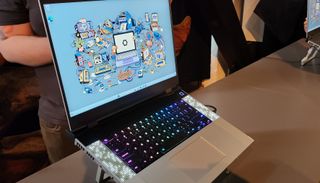Are we finally going to get a modular gaming laptop that sticks?
Framework has spent the last two years proving modular laptops are doable. Now they're coming for gaming.

In July 2022, our hardware big boss Dave James checked out the modular, user-upgradeable Framework laptop, and declared "Framework shows what notebooks should be like, and now I desperately want it to make a gaming laptop." After attending a Framework event in San Francisco today, I've got some very good news for Dave—the moment has arrived.
Framework announced the Framework 16 on Thursday, bringing its modular design to a larger system built to house dedicated GPUs. It's a 16-inch body, with an "expansion bay" system that'll allow for you to extend out the back of the laptop past the display to house larger graphics boards. Imagine a laptop that's 12 or so inches deep, from touchpad to rear exhaust, if you had an RTX 4060 on board, while a bigger, hotter RTX 4080 would be both thicker and extend an inch further in depth.
Those GPU models are purely my hypotheticals at this point: Framework isn't talking about what exact CPUs or modular graphics cards will be available for the Framework 16, which is going to start shipping in "late 2023." But we may know a bit more before long, with pre-orders set to open up sometime this spring.
As with Framework's existing laptops, you'll be able to swap out modules for the types of I/O you want: USB-C and HDMI ports, microSD slots, etc. New for the Framework 16 are keyboard options for a bigger laptop body, with an optional numpad. Framework had some cute options on display for people who don't care about the numpad, including some LED dot matrix displays playing Pong. You'll also be able to just slap in some flat panels if you want a standard centered keyboard, but the Raspberry Pi microcontrollers used for those optional features will be user-programmable if you want to get fancy.
Like much of Framework's tech, the code is open source: the company just dropped its QMK keyboard firmware on Github.
The one thing we know about the Framework 16's graphics chops is that the laptop will use a PCie Gen 4x8 interface, offering a max of 16GB/s in bandwidth. Tests have shown that's ample bandwidth for even an RTX 4090 on desktop, so I think it's fair to guess that any GPU you could cram into a Framework laptop now, or even three years from now, will be constrained by heat dissipation or potential wattage long before running into any bandwidth limitations.
But will we ever actually get a chance to slot a new GPU into the Framework 16 a few years down the line? We've seen versions of this promise so many times over the years, from desktop-replacement laptops with swappable parts to Alienware's supposedly GPU-upgradeable Area 51m to the MXM modules of the early 2010s. None of these designs have stuck. And external GPU enclosures, despite being around for a decade, have never taken off, either, even when big names like Razer have taken a stab at it.
The biggest gaming news, reviews and hardware deals
Keep up to date with the most important stories and the best deals, as picked by the PC Gamer team.


It seems like someone comes along every few years to say they've cracked it, but the trade-offs or costs have never made these options more appealing than a custom-built desktop or an ultralight laptop. Framework, at least, has played it smart up to this point: rather than jumping right into the more complex gaming laptop design, it started with the more portable Framework 13.
And Framework's open sourcing of many of its designs is at least a more enthusiastic commitment to true customization than we've ever seen from other hardware companies tackling this idea. Maybe we've finally reached the point where dedicated GPUs and other laptop components are compact enough to remain swappable across multiple hardware generations. We'll see later this year if Dave's dream is genuinely coming true.

Wes has been covering games and hardware for more than 10 years, first at tech sites like The Wirecutter and Tested before joining the PC Gamer team in 2014. Wes plays a little bit of everything, but he'll always jump at the chance to cover emulation and Japanese games.
When he's not obsessively optimizing and re-optimizing a tangle of conveyor belts in Satisfactory (it's really becoming a problem), he's probably playing a 20-year-old Final Fantasy or some opaque ASCII roguelike. With a focus on writing and editing features, he seeks out personal stories and in-depth histories from the corners of PC gaming and its niche communities. 50% pizza by volume (deep dish, to be specific).
Most Popular






